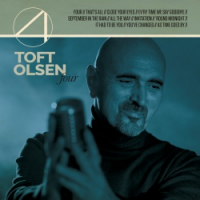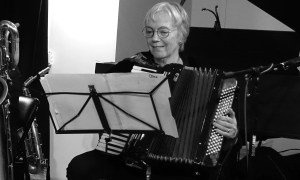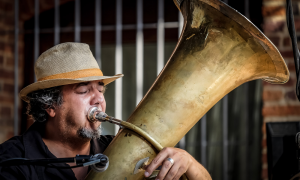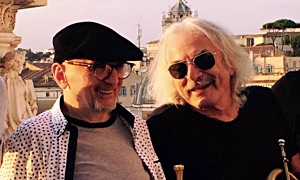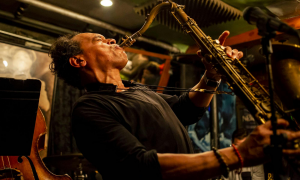Home » Jazz Articles » Musician 2 Musician » Marcus Rojas: Dancing with a Tree
Marcus Rojas: Dancing with a Tree

Courtesy Roberto Cifarelli
Music for me is physical. I think of music as bodies in motion. How does one person get from here to here? Everything I relate to music is like dancing. Even when I play avant-garde music; how can this feel a certain way? Purely feeling, not intellectualizing it in anyway. Almost to a fault
—Marcus Rojas
When it comes to the tuba most people will imagine this sound: oom pah oom pah. And that is a pretty accurate expectation of what the tuba does in many musical situations. Jazz enthusiasts will recognize its role in traditional New Orleans music and in modern jazz, Billy Barber's work on Miles Davis' iconic 1949 recording Birth of the Cool certainly stands out. Its brother, the sousaphone, is predominant at parades, sporting events and in New Orleans brass bands. But as a solo instrument the tuba was not utilized much until Joe Daley, Ray Draper, Howard Johnson and Bob Stewart opened up the possibilities. And in the hands of an improviser like Marcus Rojas the tuba has become even more expressive.
Now entering his mid—fifties he still has a thick head of hair and at times his voice has the booming confidence of a street smart New Yorker. I heard him for the first time with Spanish Fly at the old Knitting Factory as they whispered, rattled and roared through a set that was unlike any music I'd ever heard. They played so well together—flirting with tones, relaying phrases, sharing cues by osmosis—that I was completely riveted. I could see there was a friendly competitiveness between them—call it edginess—that contributed to their unique chemistry on stage. From what I could fathom, the pitches they played held as much importance as the rhythms and character of the notes and the space around those notes mattered even more.
When I asked Marcus what he thinks this mysterious kind of music should be called, he answered, "trust music."
"It's a super extension of myself, like a vibrational extension. And I can notice it when people aren't doing that. When they're playing their instrument rather than being part of it. I don't see the tuba as a partner, just part of me, you know... outward, when it's at its best. That's the only way I know how to do it, I can't make it like a separate thing. I have to immediately go to learning by feel."
This spring we met up at his place in Kensington, Brooklyn, where Marcus was attempting to remove a huge tree stump from his backyard with a hatchet. Full well knowing that it was both a dangerous and impossible task, he was fully prepared to go at it the hard way. "Do you know how to use a chainsaw?" he asked. That's a good question for a Canadian from British Columbia but I replied in the negative. Seeing Marcus survey the stump was like watching him take in a musical score. He looked it over with a gaze, shrugged and invited me into his house where we and spoke about his life in music.
"I am dyslexic, it was 5 years before I knew what the names of the notes were. I knew what the notes sounded like and what fingering to use but I didn't know what they were called. In junior high my band teacher put me on the spot asking me to start on the Db and I was panic stricken because I didn't know what it was. Even now that I know it, I still have to make a thing about it! In my world, I feel the rhythm, that's my thing. Even in melodies, the rhythmic cadences of music is just as important as the note cadences. You can tell what the chords are sometimes by how the rhythms happen in the chord. You can tell songs or the melody of the music by the rhythm of it. I think that's what is the interesting about free music, like Ornette Coleman. I definitely think it is rhythm-based music. Sure, it has the melody... but in the end the rhythm is so strong you can play any notes! That's why in bands like Spanish Fly, we liked cool notes but we could always find a better "cool note." Everything is rhythm. Molecules are not solid... everything has vibration. What makes chords interesting is the tension and release... it's so basic... everything we do is in rhythm, patterns, harmony and scales, the rhythm of the scale has an innate pattern. I never had to memorize dance steps, it's just feeling the groove. When it's put into words I can't understand it. It's preverbal, I have to learn it like I learned to dance. There's a million kind of dances and my sister could do all the steps and I would just figure it out as it was happening."
I asked Marcus about his tenure in Lester Bowie's Brass Fantasy, a world renowned ensemble led by the crafty and charismatic trumpet player from the Art Ensemble Of Chicago.
"Vinnie Johnson was the drummer and I was just trying to be Bob Stewart. There were tons of charts that he had commissioned because he didn't do much writing. When I was subbing for Bob, in the very beginning there were all these tunes that didn't have charts because Bob had just learned them. Like the tune "Crazy," it didn't sound like "Crazy" (the Willie Nelson standard), it had all this crazy shit in it and I heard all this stuff... I had never transcribed a tuba player and I transcribed at least five Bob Stewart things there weren't charts for... And the bass lines were so badass I was like "I'm going to play all this shit, it's going to be so killing." After the gig Lester said "what were you playing on "Crazy?"" I answered "Exactly what Bob played." He goes, "I don't want you to play what Bob played. I want to hear what you would do." And I was like, "What... ?, I don't know!" But he made it so clear as a leader, don't play what the other guy played. It was so inauthentic in his brain. Play it the way you would come up with."
The tuba is even bigger than I realized. A standard tuba requires the player to push air through 18 feet of tubular brass. That's 5.5 meters of metal that has to vibrate. Typically the range of the tuba covers the lower octaves of the musical spectrum but Marcus can go to the stratosphere. He can manipulate the timbre of the horn to sound like a flugelhorn, french horn, euphonium or a conch shell. He will hoot, holler, yelp and sing through his horn. He will tap it and bang the bell to reproduce a cymbal or metallic 'ding.' Maybe it's his New York roots—he grew up in Red Hook, Brooklyn—because he'll scratch a beat out like a DJ on vinyl or pop series of triplets and sixteenth notes in succession outlining patterns like one would on a conga drum. Marcus says all of this stems from his youth growing up with his Puerto Rican Mom and family with whom he developed a love for rhythm and dancing.
"If not a lot of planning, there's a lot of willfulness about about what I love about music. And so I was just trying to make it up, just trying to get to this place. I grew up in a dancing culture. I grew up with my mother, I never knew my father. The music that I grew up listening to was Latin and R&B, it had nothing to do with tuba music, or even jazz. I would never know who played on records, that seemed like the least interesting part, it was about: can I dance to it?. Can I get a groove on with this? I was a disco kid, it was like the movie with John Travolta, that was my life but like with a tuba in my hands" [I laugh] "Seriously! I wore a cream colored suit for my graduation. Music for me is physical. I think of music as bodies in motion. How does one person get from here to here? Never as a note choice. If someone is going to turn or walk to that beat, how's that going to feel? I didn't realize how strong it was but everything I relate to music is like dancing. Even when I play avant—garde music; how can this feel a certain way? Purely feeling, not intellectualizing it in anyway. Almost to a fault."
Marcus mentioned that his life in music was serendipitous and that making good music was about relationships. He equates the thrill of performing Prokofiev with that of improvising over a tune with his friends.
"Adolphe Sax had many patents but his factory burned down and he died penniless. He was the genius inventor of the tuba. The predecessor of the tuba was called an ophicleide. An ophicleide is keyed like a saxophone but you buzz it with your lips. Much of the music written for tuba wasn't actually written for tuba, it was written for ophicleide, serpent or chimbassa. It was Richard Wagner who started writing for the modern tuba. The Russian tuba tradition is the shit, Prokofiev's Fifth Symphony... He was a great orchestrator and often he would use the tuba with other instruments than just low brass. And that leads me to believe there must have been some amazing tuba players in Russia at the time because that shit is hard to play now and he was writing for these guys, more and more! Tchaikovsky wrote huge tuba parts... all those guys wrote amazing tuba stuff. The etudes as well... it's all low. The high tuba stuff comes from France. They're playing smaller tubas, like tenor tubas. Even now there's no standardization... there could be eight different sizes of tubas. Nowadays people play a six quarter tuba because it's a tuba and half! But in lots of music that doesn't work because it's too big. Many players need to have at least 3 tubas in their arsenal."
That challenges my theory that Sax's best known invention was the righteous instrument of the industrial revolution: it's not the saxophone, the tuba came first. Marcus also spoke about how military brass bands spread both the language of brass music and the actual instruments. For example in the US, after the civil war, loads of brass instruments were left behind and people started playing music with them. This would explain how the brass band tradition in New Orleans came to be. Naturally with so many different cultures melting together in one place musicians would adapt and out of necessity would perform the most relevant styles of popular music of that era.
"When I got hip to Kirk Joseph of the Dirty Dozen Brass Band I stole so much from him. He's like the Jaco Pastorius of modern tuba. He's as important to modern New Orleans tuba playing as Bob Stewart is to modern jazz tuba playing. He took all the bass lines from The Meters and applied them to the tuba. Unbelievable! When I first heard "Feet Don't Fail Me Now" I didn't even know the tuba was a tuba. He was just playing the baddest shit that he invented! I transcribed everything from that record and you could feel the dance. You could feel an audience full of people dancing when you put on that music. That was giantly influential."
Marcus attended High School at New York City's famed School for Music and Art where he shared classes with the children of established musicians and artists. He was exposed to a lot of music and people from different cultures and classes.
"It was a really cool place then and they're changing it now, they're making it harder to get in grade wise and it was supposed to be set up so as long as you were passing you could get in and have a place to practice three or four hours a day. So you were around all these amazing musicians from all over the city, inner city kids and kids who could have gone to private school were there whose parents went there and they were hip because a lot of the their parents were artists and musicians. Ron Carter's son was in my grade, Reggie Workman's daughter... and New York City in the 70's was so mellow then. You could go to a bar and you wouldn't get carded. There was an equal opposite thing to all the rough stuff going on, but it never got to the point where it was like Detroit and everyone left. It was always kind of an intense and dangerous city but if you're from the city then you always understand the dangers of it. Because the police department was so under-manned you could do what you wanted. I used to watch them blow up the balloons before Macy's thanksgiving day parade and you could just hang out and walk around under the balloons. Everyone always danced all over the place. I'm a very tactile person and music for me is tactile, I need to get close to something and touch it. There was spray painting all over and people were using everything [in the city] for their canvas and you could feel people's expression of their lives more physically."
After eating some delicious Bangladeshi food in his neighborhood we started back to his place. We were walking and sharing thoughts about our kids and the world they will inherit. I could sense a dark cloud floating over us relating to today's political and social issues when Marcus suddenly stopped in front of a tree and became quite animated. He grasped the trunk and exclaimed, "Look at this tree! It's beautiful! There's so much to take in. Look up!" And I did. I saw the bark peeling and noticed how other trees on the block were leaning in the same manner and I wondered if they were pushed into that pose by Hurricane Sandy. He yanked on my arm, "Feel this thing!" It had been ages since I hugged a tree.
A few yards further along we came across a man on his stoop playing a harmonica so we stopped to listen. He sounded alright but that didn't matter because the coincidence of all these things happening in the moment was so gratifying. For now, let's forget all the bullshit and breath in this life. As Marcus might often say after a good rehearsal, "We are so lucky!." The harmonica dude said he needed some other guys to play with him. We both smiled and went on our way. Besides, Marcus still had that tree stump to dig out.
Tags
Musician 2 Musician
Marcus Rojas
Ludovico Granvassu
Henry Threadgill
Paul Simon
Sting
Lester Bowie
Spanish Fly
Steven Bernstein
David Tronzo
Bill Barber
Miles Davis
Joe Daley
Ray Draper
Howard Johnson
Bob Stewart
Ornette Coleman
Art Ensemble of Chicago
Vinnie Johnson
Kirk Joseph
Dirty Dozen Brass Band
Jaco Pastorius
Ron Carter
Reggie Workman
PREVIOUS / NEXT
Support All About Jazz
 All About Jazz has been a pillar of jazz since 1995, championing it as an art form and, more importantly, supporting the musicians who make it. Our enduring commitment has made "AAJ" one of the most culturally important websites of its kind, read by hundreds of thousands of fans, musicians and industry figures every month.
All About Jazz has been a pillar of jazz since 1995, championing it as an art form and, more importantly, supporting the musicians who make it. Our enduring commitment has made "AAJ" one of the most culturally important websites of its kind, read by hundreds of thousands of fans, musicians and industry figures every month.




